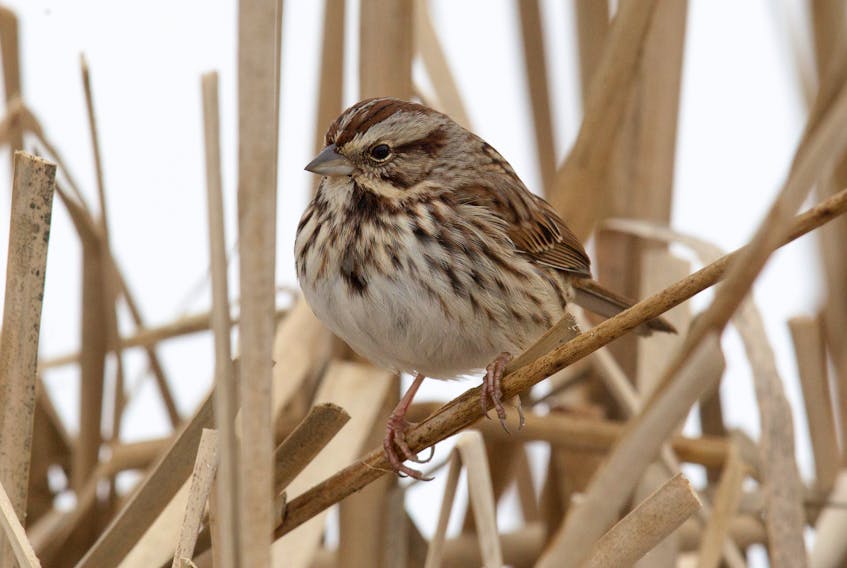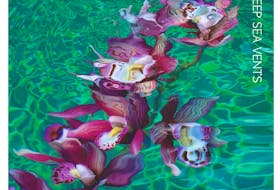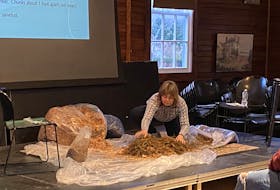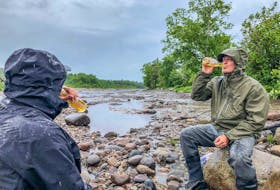
The snowy weather has made for an active bird feeding season. American goldfinches, northern flickers, blue jays, juncos and black-capped chickadees are the mainstay of our bird feeders. Some people are lucky enough to also have some evening grosbeaks, purple finches, pine siskins, red-breasted nuthatches, hairy and downy woodpeckers or mourning doves. Small numbers of sparrows are also with us in the winter. Not every bird feeder gets a winter sparrow but this winter there are a lot more of them to go around.
The three species of sparrow most often found at bird feeders in the winter are the song, white-throated and fox sparrow. The song sparrow is the most routine of these. With a friendly disposition they freely associate with the juncos. It is a dull brown bird with strong brown stripes on the breast that congeal into a central breast spot. They prefer being near edges of brooks and ponds but can show up anywhere with the juncos. Quite hardy, they withstand the worst of wintry weather with a good food supply.
It is interesting to watch the two or three song sparrows at Quidi Vidi Lake by the Virginia River outlet. The ducks loaf about there in the parking lot waiting for a kind citizen to bring them duck food or bird seed. When the ducks think they have vacuumed up all the food they resume the resting position again. This is when the song sparrows spring into action. They hop over the ground picking up what the ducks missed. During hard times I put out seed specifically for these hardy song sparrows in a place I hope the ducks will not go. The attached photograph is one of these Quidi Vidi Lake special little song sparrows.
White-throated sparrows are putting in a strong appearance this winter on the Avalon Peninsula at least. I cannot think of any particular reason why. These are very capable feeder birds. Only the males have the sharp black-and-white head stripes. The females and immature birds have the same overall pattern but with duller head stripes. The best way to know a white-throated sparrow from a song sparrow is the lack of bold streaking on the breast. Some feeders on the southern Avalon Peninsula have five or more white-throated sparrows visiting daily. The fox sparrow is the least common of this trio of sparrows but the most attractive. Fox sparrows are like big red-coloured song sparrows. The bright rusty streaking, wings and tail with a contrasting grey face are diagnostic. They are diggers. By habit they scratch the ground vigorously looking for the seeds. This could be your winter to see one.
There are other rarer species of sparrows that some of you may have seen at your bird feeder. The American tree sparrow has a rusty cap and a black spot in the middle of it clear grey breast. The white-crowned sparrow looks a little like the white-throated sparrow without the white throat. And then there is the house sparrow. This is not technically a sparrow but is actually a member of the weaver finch family. However, they are brown like a sparrow. House sparrows are almost always in small flocks. The males have a black patch on the breast and the females have a plain brown breast with a broad pale line over the eye. They are the ones that nest in bird boxes
Savannah sparrows are a bird of summer fields and open places that will sometimes try to overwinter in areas of extensive beach grass also called marram grass. They rarely end up at bird feeders but at Cape Spear there is a savannah sparrow trying to tough out the winter. It is of the Ipswich race that nests only on Sable Island, Nova Scotia. It showed up in November after a storm. The Ipswich savannah sparrow is distinguished from your ordinary savannah sparrows by its larger size and pale sandy colour. Birders are putting in a special effort to keep seed available for this wayward sparrow. So far it appears to be doing well but is not too happy sharing the seed with a couple of dozen snow buntings that have moved in to enjoy the offerings.
I keep hoping that rare golden-crowned sparrow that was at a Clara Dunne’s bird feeder in Renews for five days in December will turn up at another bird feeder. A rare eastern towhee, like a large version of a sparrow, was photographed at a bird feeder in the Renews area by Linda Cutler Kenny. Not related to the sparrows but a nice feeder bird is the brightly coloured yellow-breasted chat at Pam Mainwaring feeder on Exeter Avenue in St. John’s.
I am sure there are other interesting birds out there that we do not know about yet. What is at your bird feeder?
Bruce Mactavish is an environmental consultant and avid birdwatcher. He can be reached at [email protected]









